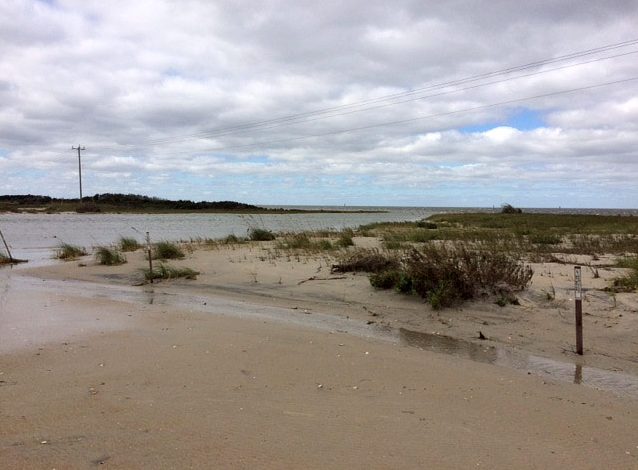A late 2019 project orchestrated by Tideland Electric Membership Corporation (EMC) will effectively remove the aerial power lines from Pole Road at the southern end of Hatteras Island, switching to a submarine cable that will be far more reliable in the years to come.
“Technically, [that stretch] will no longer be Pole Road, because there will no longer be poles,” said Cape Hatteras National Seashore Superintendent David Hallac at a December public meeting in Buxton. “But the [ORV] beach access will still be there.”
Formally known as Ramp 55, but referred to by Hatteras locals as Pole Road, this section of shoreline that borders Hatteras Inlet has lost an estimated 1.5 miles of land since Hurricane Isabel in 2003.
“The erosion in that area has gradually done a number on the southern end of Hatteras Island, and has gotten significantly worse since Superstorm Sandy in 2012,” said Tideland EMC Manager of Corporate Communications Heidi Jernigan Smith. “This has necessitated us to [move] about 9,800 feet cable from aerial to underground.”
This southern terminal of Hatteras Island is also the hand-off point from Cape Hatteras Electric Cooperative to Tideland EMC, with the string of aerial power lines and submarine cables providing the connection to power for Ocracoke Island.
And with the shoreline gradually disappearing, a move to submarine cables is required to ensure that this connection stays intact.
“There have been some pretty significant impacts [in that area] from Hurricane Florence,” said Hallac. “It’s disorienting, because the road has completely merged with the beach.”
The move from aerial to an underground cable for the roughly two-mile stretch of beach was originally slated to begin in February of 2019, but several factors caused the project to be pushed back to December, 2019.
“For one thing, the cable is so heavy that it has to come in by barge,” said Smith. “There are logistics [to consider], as well as a certain window of time that we can do the work, because we do have to apply for a federal permit as well. As such, the earliest window of opportunity will be December of 2019.”
The delayed start date may be a concern if a strong storm impacts the area during the 2019 hurricane season, but it also has a silver lining in terms of potential funding for the roughly $3 million dollar endeavor.
“We’re more exposed with each storm and major weather event that impacts that area, but by the same token, we’re hoping some other things may fall into place – in particular, we have applied for some hazard mitigation funding,” said Smith. “There are so many hazard mitigation projects in the Southeast that are in the works, but we will probably get a little more attention from the hazard mitigation funding source, which will help us [obtain] some outside funds to help with the expenses.”
“Anything we can realize that would help us offset that expense would be greatly appreciated by our entire membership,” Smith added.
Smith also noted that with or without hazard mitigation funding, the project is one of many major projects that Tideland EMC tackles every couple of years in the six counties it represents. “Operational expenses are generally more forgiving, as you can expense those over time,” she said, “and this isn’t our largest operational project in recent years.”
Though the project is currently a year away, once in process, it will take roughly a month to complete, and in the end, Ocracoke Islanders will have a much safer and more reliable power source – regardless of how the beach bordering Hatteras Inlet changes in the years to come.
“One thing that we do know if that once we put in that submarine cable that’s currently [being used] across Hatteras Inlet, it’s a headache-free cable,” said Smith. “We think that this project buys us a big bit of reliability. It’s not impervious, but it’s pretty close, and that’s important to our residents and guests on Ocracoke – that there is a reliable connection to get power to the island.”









